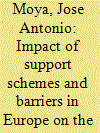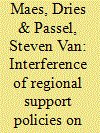|
|
|
Sort Order |
|
|
|
Items / Page
|
|
|
|
|
|
|
| Srl | Item |
| 1 |
ID:
111450


|
|
|
|
|
| Publication |
2012.
|
| Summary/Abstract |
Although the benefits of distributed cogeneration are widely cited, adoption has been slow in the United States. Adoption could be encouraged by making cogeneration more economically attractive, either by increasing the expected returns or decreasing the risks of such investments. We evaluate the expected returns from demand response, capacity markets, regulation markets, accelerated depreciation, pricing CO2 emissions, and net metering. We find that (1) there is an incentive to overcommit in the capacity market due to lenient non-response penalties, (2) there is significant revenue potential in the regulation market, though demand-side resources are yet to participate, (3) a price on CO2 emissions will make cogeneration more attractive relative to conventional, utility-supplied energy, and (4) accelerated depreciation is an easy and effective mechanism for improving the economics of cogeneration. We go on to argue that uncertainty in fuel and electricity prices present a significant risk to cogeneration projects, and we evaluate the effectiveness of feed-in tariffs at mitigating these risks. We find that guaranteeing a fixed electricity payment is not effective. A two-part feed-in tariff, with an annual capacity payment and an energy payment that adjusts with fuel costs, can eliminate energy-price risks.
|
|
|
|
|
|
|
|
|
|
|
|
|
|
|
|
| 2 |
ID:
110736


|
|
|
|
|
| Publication |
2011.
|
| Summary/Abstract |
Developing long-term carbon control strategies is important in energy intensive industries such as the oil sands operations in Alberta. We examine the use of cogeneration to satisfy the energy demands of oil sands operations in Alberta in the context of carbon management. This paper evaluates the role of cogeneration in meeting Provincial carbon management goals and discusses the arbitrary characteristics of facility- and product-based carbon emissions control regulations. We model an oil sands operation that operates with and without incorporated cogeneration. We compare CO2 emissions and associated costs under different carbon emissions control regulations, including the present carbon emissions control regulation of Alberta. The results suggest that incorporating cogeneration into the growing oil sands industry could contribute in the near-term to reducing CO2 emissions in Alberta. This analysis also shows that the different accounting methods and calculations of electricity offsets could lead to very different levels of incentives for cogeneration. Regulations that attempt to manage emissions on a product and facility basis may become arbitrary and complex as regulators attempt to approximate the effect of an economy-wide carbon price.
|
|
|
|
|
|
|
|
|
|
|
|
|
|
|
|
| 3 |
ID:
125401


|
|
|
|
|
| Publication |
2013.
|
| Summary/Abstract |
In this paper, we design and evaluate eight different strategies for hedging commodity price risks of industrial cogeneration plants. Price developments are parameterized based on EEX data from 2008 to 2011. The probability distributions derived are used to determine the value-at-risk (VaR) of the individual strategies, which are in a final step combined in a mean-variance portfolio analysis for determining the most efficient hedging strategy. We find that the strategy adopted can have a marked influence on the remaining price risk. Quarter futures are found to be particularly well suited for reducing market price risk. In contrast, spot trading of CO2 certificates is found to be preferable compared to forward market trading. Finally, portfolio optimization shows that a mix of various hedging strategies can further improve the profitability of a heat-based cogeneration plant.
|
|
|
|
|
|
|
|
|
|
|
|
|
|
|
|
| 4 |
ID:
105800


|
|
|
|
|
| Publication |
2011.
|
| Summary/Abstract |
Nowadays all countries are developing their own policies to promote cogeneration in the small-scale residential sector. In this paper the feasibility of small-scale gas engine-based residential cogeneration plants under the current Spanish regulation is studied. A unitary thermal load profile is obtained to characterised the thermal demand of residential applications in Spain. This unitary profile is used to analyse the potential of cogeneration in the small-scale range of powers (100-1000 kW). A complete characterisation of the gas fuelled engines in the market is performed and subsequently used to evaluate the economic feasibility within the selected range by means of a self-tailored simulation model. It is underlined how the thermal storage is a crucial element that should be suitably included in a residential cogeneration plant and the distortions that the actual pricing system adds to the profitability of residential plants of different sizes. Finally a sensibility study is carried out in order to evaluate how the Spanish regulation is able to deal with future variations in the energy prices. It is shown that a rise in the price of the natural gas increases the current feasibility of a plant while a decrease descends the profitability.
|
|
|
|
|
|
|
|
|
|
|
|
|
|
|
|
| 5 |
ID:
124301


|
|
|
|
|
| Publication |
2013.
|
| Summary/Abstract |
This paper analyses the effectiveness of different support measures to promote cogeneration in the European Union. The analysis looks into the average progress of cogeneration between two different periods. The economic effect of the support measures in each country is quantified with the help of a cost-benefit analysis carried out by the Cogeneration Observatory and Dissemination Europe (CODE) project. The scope of this study is necessarily affected by the need to limit the number of projects and support measures. However, there is no evidence of a relationship between the economic advantage offered by support measures and the deployment of cogeneration in the Member States. The study considers the effect of different barriers (reported by the Member States) on the promotion of cogeneration. The individual analyses of the barriers differ widely in quality and depth. When some barriers are reported, there is an increase of the variability of the penetration of cogeneration. This counter-intuitive fact leads us to conclude that there is a lack of consistency in the barriers reported, and a clear need for consistent reporting on barriers. The possible effect of competition between measures supporting combined heat and power and renewable energy sources is also analysed.
|
|
|
|
|
|
|
|
|
|
|
|
|
|
|
|
| 6 |
ID:
111460


|
|
|
|
|
| Publication |
2012.
|
| Summary/Abstract |
This paper assesses unintentional interference between different public policies promoting energy efficiency and renewable energy. The paper develops a methodology to study the interference by analysing the economic and technical behaviour of a hybrid energy system. The hybrid energy system in this case consists of an existing cogeneration unit extended with a new installation of thermal solar panels. This puts two complementary heating technologies in juxtaposition. The two technologies are supported with distinct regional support instruments in each region. The design and operation of the energy system is optimised from the point of view of the investor according to the different support instruments. The optimal configuration is analysed as well as its effect on reduced CO2-emissions during the lifetime of the project. The methodology is applied to a case-study for two neighbouring regions, the Netherlands and Flanders. The policies in the Netherlands show a beneficial synergy. In Flanders, the hybrid energy system is not interesting, indicating unbalanced high support for cogeneration in this case. From the point of view of the authorities, a more balanced regional policy as in the Netherlands provides a larger CO2-emission reduction for a smaller cost.
|
|
|
|
|
|
|
|
|
|
|
|
|
|
|
|
| 7 |
ID:
101399


|
|
|
|
|
| Publication |
2011.
|
| Summary/Abstract |
The paper presents the birth and evolution of the cogeneration-based district heating (DH) system in a medium size city in Romania (Targoviste). The evolution of the industrialization degree was the main factor which controlled the population growth and led to a continuous reconfiguration of the DH system. The DH system assisted by cogeneration emerged as a solution in a certain phase of the demographic development of the city. The political and social changes occurring in Romania after 1990 have had important negative consequences on the DH systems in small towns. In Targoviste the DH system survived but in 2001 the solution based on cogeneration became economically inefficient, due to the low technical quality of the existing equipment and the low gas prices, to the procedure of setting the DH tariffs and the service cost at consumer's level and to some bureaucratic problems. Energy policy measures taken at national and local levels in 2003 and 2005 led to the re-establishment of the cogeneration-based district heating in 2005. However, a different technical solution has been adopted. Details about the present (2009) cogeneration-based DH system in Targoviste are presented together with several technical and economical indicators. The main conclusion is that by a proper amendment of the technical solutions, cogeneration could be a viable solution for DH even in case of abrupt social and demographic changes, such as those occurring in Romania after 1990.
|
|
|
|
|
|
|
|
|
|
|
|
|
|
|
|
| 8 |
ID:
092803


|
|
|
|
|
| Publication |
2009.
|
| Summary/Abstract |
The European Commission has adopted Directive 2004/8/EC on the promotion of cogeneration, which the EU Member States, as well as candidates including Croatia, were obliged to accept. Among other terms and conditions, the Directive requires certain support mechanisms, such as feed-in tariff prices and premiums added to market electricity prices. In this paper, the cost effectiveness of selling electricity at the feed-in tariff prices in the selected EU Member States is compared to selling it on the European electricity market, with or without premiums. The results of this comparison will indicate whether correction of the Croatian feed-in tariff price to a higher value would be justified. The cost effectiveness ratio of a cogeneration unit upgraded with mean reverting and jump diffusion processes is used for comparison. At the end of this paper, a method is suggested for the correction of feed-in tariff prices, with examples of corrected prices for the years 2008 and 2009. Such corrections have been proven to be justified and are compared to the feed-in tariff prices in most of the selected EU Member States.
|
|
|
|
|
|
|
|
|
|
|
|
|
|
|
|
| 9 |
ID:
124250


|
|
|
|
|
| Publication |
2013.
|
| Summary/Abstract |
As one of the most significant measures to improve energy utilization efficiency and save energy, cogeneration or combined heat and power (CHP) has been widely applied and promoted with positive motivations in many countries. A rational cost allocation model should indicate the performance of cogenerations and balance the benefits between electricity generation and heat production. Based on the second law of thermodynamics, the present paper proposes an entropy change method for cost allocation by choosing exhaust steam entropy as a datum point, and the new model works in conjunction with entropy change and irreversibility during energy conversion processes. The allocation ratios of heat cost with the present and existing methods are compared for different types of cogenerations. Results show that the allocation ratios with the entropy change method are more rational and the cost allocation model can make up some limitations involved in other approaches. The future energy policies and innovational directions for cogenerations and heat consumers should be developed.
|
|
|
|
|
|
|
|
|
|
|
|
|
|
|
|
| 10 |
ID:
180161


|
|
|
|
|
| Summary/Abstract |
Increasing use of renewable energy requires sufficient grid flexibility to address uncertainty and variability in electricity generation. Previous studies suggest that combined heat and power (CHP) systems may support grid flexibility but they do not consider operating hours. In this paper, we used CHP operating data and determined annual and monthly availability of the installed CHP capacity from various sectors (e.g., utility, independent power producer, commercial, and industrial) in all seven U.S. independent system operators (ISOs) and regional transmission organizations (RTOs). Also, we estimated hourly CHP availability installed in five facility types (i.e., hospitals, universities, hotels, offices, and manufacturing) in the state of New York. The results show that regardless of ISO/RTO, sector, or season, more than 40% of the installed CHP capacity (0.7–8.7 GW) was not fully utilized in 2019; the results are similar for 2018. This available CHP capacity accounted for up to 9% of the ISO/RTO's peak electric demand, which may yield cost savings up to $16 billion by avoiding installation costs of new natural gas combustion or combined-cycle turbines. To exploit the available CHP capacity to enhance grid flexibility, we recommend different policy implications including flexible contract lengths between CHP owners and grid operators, improved market designs, and simplified interconnection standards.
|
|
|
|
|
|
|
|
|
|
|
|
|
|
|
|
| 11 |
ID:
116706


|
|
|
|
|
| Publication |
2012.
|
| Summary/Abstract |
In recent years there have been several discussions on a greater use of natural gas nationwide. Moreover, there have been several announcements by the private and public sectors regarding the construction of new pipelines to supply natural gas to the Peruvian southern and central-north markets. This paper presents future scenarios for the use of natural gas in the large-sized industrial and commercial sectors of the country based on different hypotheses on developments in the natural gas industry, national economic growth, energy prices, technological changes and investment decisions. First, the paper estimates the market potential and characterizes the energy consumption. Then it makes a selection of technological alternatives for the use of natural gas, and it makes an energetic and economic analysis and economic feasibility. Finally, the potential use of natural gas is calculated through nine different scenarios. The natural gas use in cogeneration systems is presented as an alternative to contribute to the installed power capacity of the country. Considering the introduction of the cogeneration in the optimistic-advanced scenario and assuming that all of their conditions would be put into practice, in 2020, the share of the cogeneration in electricity production in Peru would be 9.9%.
|
|
|
|
|
|
|
|
|
|
|
|
|
|
|
|
| 12 |
ID:
117242


|
|
|
|
|
| Publication |
2013.
|
| Summary/Abstract |
Improving the energy economics of manufacturing is essential to revitalizing the industrial base of advanced economies. This paper evaluates ex-ante a federal policy option aimed at promoting industrial cogeneration-the production of heat and electricity in a single energy-efficient process. Detailed analysis using the National Energy Modeling System (NEMS) and spreadsheet calculations suggest that industrial cogeneration could meet 18% of U.S. electricity requirements by 2035, compared with its current 8.9% market share. Substituting less efficient utility-scale power plants with cogeneration systems would produce numerous economic and environmental benefits, but would also create an assortment of losers and winners. Multiple perspectives to benefit/cost analysis are therefore valuable. Our results indicate that the federal cogeneration policy would be highly favorable to manufacturers and the public sector, cutting energy bills, generating billions of dollars in electricity sales, making producers more competitive, and reducing pollution. Most traditional utilities, on the other hand, would lose revenues unless their rate recovery procedures are adjusted to prevent the loss of profits due to customer owned generation and the erosion of utility sales. From a public policy perspective, deadweight losses would be introduced by market-distorting federal incentives (ranging annually from $30 to $150 million), but these losses are much smaller than the estimated net social benefits of the federal cogeneration policy.
|
|
|
|
|
|
|
|
|
|
|
|
|
|
|
|
| 13 |
ID:
180845


|
|
|
|
|
| Summary/Abstract |
In many countries the role of combined heat & power (CHP) generation in the power & heat sector is significant. However, in decomposition analyses of the power & heat sector the contribution of CHP to observed changes in primary energy use or CO2 emissions is generally not made explicit. In this paper, the contribution of CHP is shown for eight countries (China, Denmark, France, Germany, Italy, the Netherlands, Poland and the USA) in the period 2005–2016. In addition, an alternative method is proposed for power & heat sector decomposition analysis with five driving factors: volume effect, subsector effect, heat effect, fuel mix effect and efficiency effect. This method combines indicators from existing decomposition methods and complements them with a CHP specific heat effect. The proposed method provides improved insight in the factors driving change in primary energy use or CO2 emissions in the power and heat sector, especially in case changes take place regarding either 1) the power-to-heat ratio, 2) the share of CHP electricity in total electricity production, 3) the CHP fuel mix, and/or 4) the efficiency of individual CHP fuels.
|
|
|
|
|
|
|
|
|
|
|
|
|
|
|
|
|
|
|
|
|